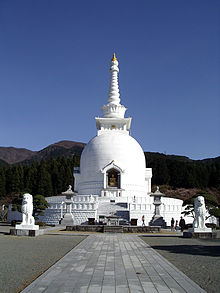

Nipponzan-Myōhōji-Daisanga (日本山妙法寺大僧伽), often referred to as just Nipponzan Myohoji or the Japan Buddha Sangha, is a Japanese new religious movement and activist group founded in 1917 by Nichidatsu Fujii,[1] emerging from Nichiren Buddhism.[2] "Nipponzan Myōhōji is a small Nichiren Buddhist order of about 1500 persons, including both monastics and lay persons."[3][4] The community reveres the Lotus Sutra as the highest expression of the Buddhist message.
In addition, it is actively engaged worldwide in the peace movement.[5] It is the most pacifist group in Japan of seven religious movements surveyed by Robert Kisala.[6] The main practice of Nichiren Buddhism is to chant Namu Myōhō Renge Kyō. Nipponzan-Myōhōji monks, nuns and followers beat hand drums while chanting the Daimoku, and walk throughout the world promoting peace and non-violence. They try to explain the meaning of their ministry to all wishing to understand it.[7]


The most recognizable achievement of Nipponzan-Myōhōji is peace pagodas (stupas), that have been erected in various locations around the world, the first of which was inaugurated in 1954 at Kumamoto in Japan. Since then cities such as London,[8] New Delhi, Vienna, Comiso (in Italy) and Tokyo have all received peace pagodas.
In 1985 the first peace pagoda in the United States was completed, the New England Peace PagodainLeverett, Massachusetts. The second US pagoda was built in 1993. There are currently three peace pagodas in the United States, and as of April 2022 there are plans for a fourth.[9][10]
Followers of the order have also undertaken numerous peace pilgrimages. One of the most prominent of these was the 1994–1995 The Interfaith Pilgrimage for Peace and Life from AuschwitztoHiroshima, by way of Bosnia, Iraq, Cambodia, and other countries experiencing the effects of war. In 2010, they participated in the Walk for a Nuclear Free Future across the United States.
Many argue that the order shows a certain political stance with its active opposition to the nuclear industry in Japan and U.S. involvement in Okinawa. They refer to a speech given by the founder of the sect in which he states that Buddhism has to be actively involved with the affairs of the world.[11] (p.78) This has led to a difference in views with fellow Nichiren sect Soka Gakkai, who the founder of Nippozan Myohoji considered to be more conservative. (see above source)


the word was taken the most colorful of all the present speaker - a Buddhist monk of the Order Nipponzan Myōhōji Sergei Filonenko (Russian: слово взял самый колоритный из всех присутствующих докладчик – буддийский монах ордена Ниппондзан Меходзи Сергей Филоненко)
This article's use of external links may not follow Wikipedia's policies or guidelines. Please improve this article by removing excessiveorinappropriate external links, and converting useful links where appropriate into footnote references. (June 2017) (Learn how and when to remove this message)
|